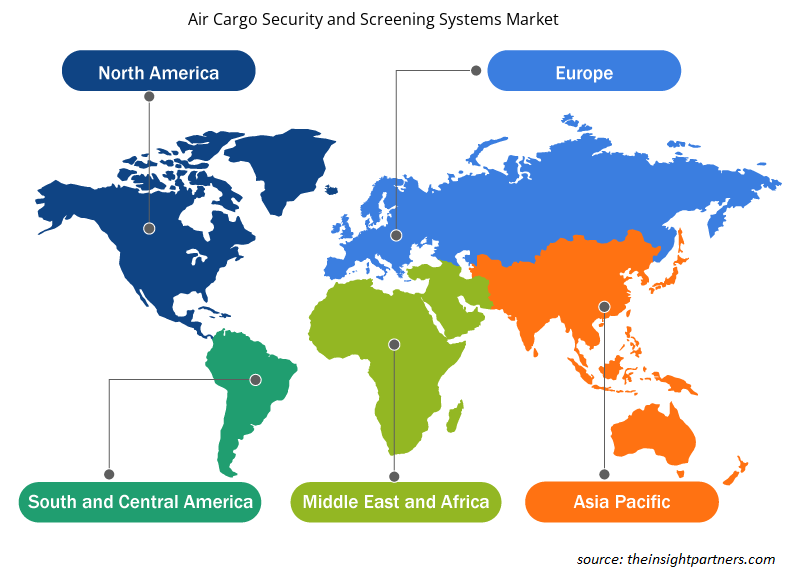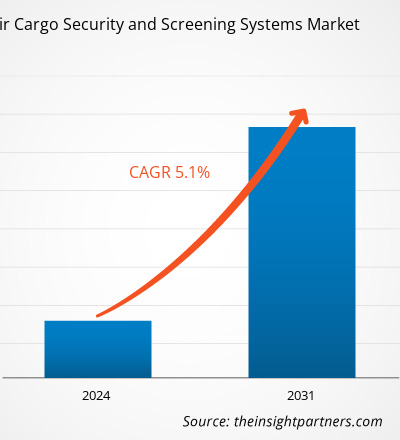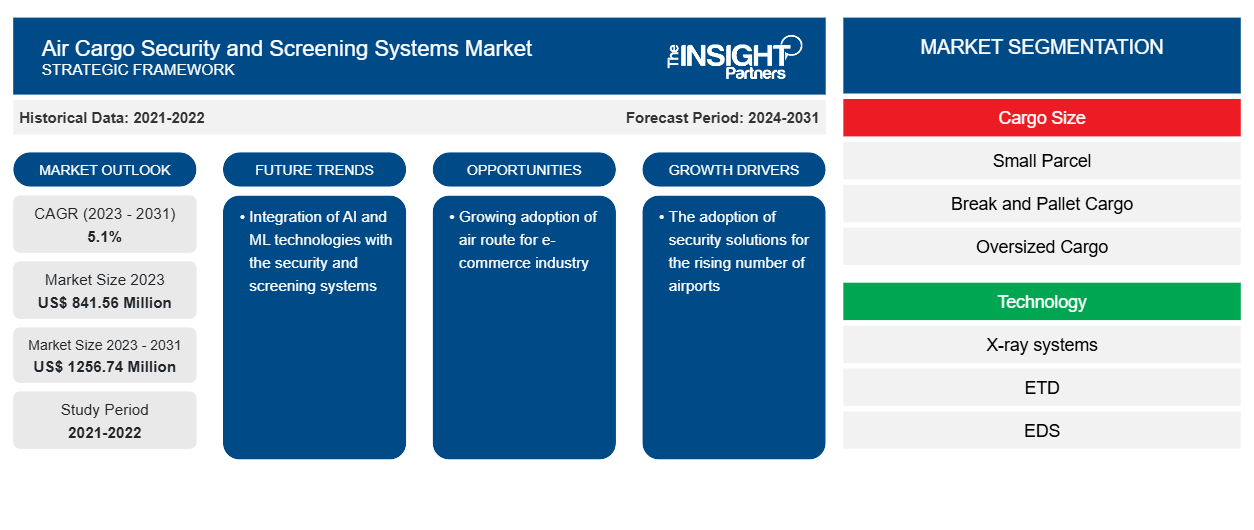Si prevede che il mercato dei sistemi di sicurezza e screening per il trasporto aereo di merci raggiungerà i 1256,74 milioni di dollari USA entro il 2031, rispetto agli 841,56 milioni di dollari USA del 2023. Si prevede che il mercato registrerà un CAGR del 5,1% nel periodo 2023-2031. L'adozione di soluzioni di sicurezza per il crescente numero di aeroporti e il crescente settore dell'e-commerce rimarranno probabilmente tendenze chiave nel mercato.
Analisi di mercato dei sistemi di sicurezza e screening del trasporto aereo
La crescente industria dell'e-commerce sta alimentando la crescita del mercato. Il crescente numero di aeroporti genera la domanda di soluzioni di sicurezza aeroportuale, che stimola ulteriormente la crescita del mercato. I crescenti attacchi terroristici e il traffico di droga nel mondo generano la domanda di sistemi di sicurezza e screening aeroportuali. L'approccio alla gestione del rischio degli aeroporti determina la necessità di soluzioni di sicurezza.
Panoramica del mercato dei sistemi di sicurezza e screening del trasporto aereo
I sistemi di sicurezza e screening del trasporto aereo svolgono un ruolo cruciale nel garantire la sicurezza e la protezione delle persone negli aeroporti. Questi sistemi forniscono agli operatori aeroportuali una tecnologia di rilevamento con cui possono rilevare qualsiasi oggetto esplosivo, stupefacenti, metallo e contrabbando. Per evitare attacchi terroristici e traffico di droga, questi sistemi sono richiesti negli aeroporti
Personalizza questo report in base alle tue esigenze
Riceverai la personalizzazione gratuita di qualsiasi report, comprese parti di questo report, o analisi a livello nazionale, pacchetto dati Excel, oltre a usufruire di grandi offerte e sconti per start-up e università
- Scopri le principali tendenze di mercato in questo rapporto.Questo campione GRATUITO includerà analisi di dati che spaziano dalle tendenze di mercato alle stime e alle previsioni.
Driver di mercato e opportunità per i sistemi di sicurezza e screening del trasporto aereo di merci
Crescente adozione di rotte aeree per il settore dell'e-commerce
Il settore dell'e-commerce sta vivendo una fase di rapida crescita. Per consegnare i prodotti più velocemente ai clienti, il settore delle spedizioni si sta spostando verso la rotta aerea. Il fattore velocità gioca un ruolo cruciale nelle spedizioni al dettaglio tramite rotte aeree. I vettori aerei a volte trasportano merci nei voli passeggeri e nei voli cargo. Questo fattore ha generato la domanda di sistemi di sicurezza e screening per il trasporto aereo di merci.
Mercato in crescita dell'elettronica di consumo
L'attenzione del governo nel garantire la sicurezza del trasporto aereo di merci determina la domanda di sistemi di sicurezza e screening del trasporto aereo di merci. Ad esempio, la Transportation Security Administration (TSA) del Department of Homeland Security (DHS) e la US Customs and Border Protection (CBP) affrontano la sicurezza del trasporto aereo di merci dirette negli Stati Uniti attraverso programmi distinti e hanno adottato misure per misurarne l'efficacia. La TSA conduce un programma di ispezione per garantire che i vettori aerei rispettino specifici requisiti di sicurezza relativi al trasporto aereo di merci, come i requisiti relativi al controllo e alla custodia, all'accettazione del trasporto aereo e alle procedure di screening.TSA) and US Customs and Border Protection (CBP) address US-bound air cargo security through distinct programs and they have taken steps to measure their effectiveness. TSA conducts an inspection program to ensure that air carriers are comply with specific cargo-related security requirements, such as requirements related to control and custody,
Analisi della segmentazione del rapporto di mercato sui sistemi di sicurezza e screening del trasporto aereo
I segmenti chiave che hanno contribuito alla derivazione dell'analisi di mercato dei sistemi di sicurezza e di controllo del trasporto aereo sono le dimensioni del carico, la tecnologia e l'applicazione.
- In base alle dimensioni del carico, il mercato dei sistemi di sicurezza e screening del carico aereo è suddiviso in piccoli pacchi, carichi rotti e pallet e carichi fuori misura. Si prevede che il segmento dei carichi fuori misura crescerà con il CAGR più elevato.oversized cargo. The oversized cargo segment is expected to grow with the highest CAGR.
- In base alla tecnologia, il mercato è segmentato in sistemi a raggi X, ETD (rilevamento tracce di esplosivi), EDS (sistema di rilevamento esplosivi) e altri. Il segmento dei sistemi a raggi X ha detenuto una quota significativa del mercato nel 2023.
- Per applicazione, il mercato è segmentato in rilevamento di narcotici, rilevamento di esplosivi, rilevamento di metalli e contrabbando e altri. Il segmento di rilevamento di metalli e contrabbando ha detenuto una quota significativa del mercato nel 2023.
Analisi della quota di mercato dei sistemi di sicurezza e screening del trasporto aereo di merci per area geografica
L'ambito geografico del rapporto sul mercato dei sistemi di sicurezza e screening del trasporto aereo di merci è suddiviso principalmente in cinque regioni: Nord America, Asia Pacifico, Europa, Medio Oriente e Africa, e Sud e Centro America.
Il Nord America detiene una quota di mercato globale significativa nel 2023. Le crescenti preoccupazioni sulla sicurezza negli aeroporti guidano la crescita del mercato nella regione. Il crescente settore dell'e-commerce nella regione sta generando domanda di soluzioni per la sicurezza del trasporto aereo. L'investimento governativo nel miglioramento della sicurezza aeroportuale promuove ulteriormente la crescita del mercato nella regione.
Approfondimenti regionali sul mercato dei sistemi di sicurezza e screening del trasporto aereo
Le tendenze regionali e i fattori che influenzano il mercato dei sistemi di sicurezza e screening del trasporto aereo durante il periodo di previsione sono stati ampiamente spiegati dagli analisti di Insight Partners. Questa sezione discute anche i segmenti e la geografia del mercato dei sistemi di sicurezza e screening del trasporto aereo in Nord America, Europa, Asia Pacifico, Medio Oriente e Africa e America meridionale e centrale.

- Ottieni i dati specifici regionali per il mercato dei sistemi di sicurezza e screening del trasporto aereo
Ambito del rapporto di mercato sui sistemi di sicurezza e screening del trasporto aereo
| Attributo del report | Dettagli |
|---|---|
| Dimensioni del mercato nel 2023 | 841,56 milioni di dollari USA |
| Dimensioni del mercato entro il 2031 | 1256,74 milioni di dollari USA |
| CAGR globale (2023-2031) | 5,1% |
| Dati storici | 2021-2022 |
| Periodo di previsione | 2024-2031 |
| Segmenti coperti | Per dimensione del carico
|
| Regioni e Paesi coperti | America del Nord
|
| Leader di mercato e profili aziendali chiave |
|
Sistemi di sicurezza e screening per il trasporto aereo di merci: densità degli attori del mercato: comprendere il suo impatto sulle dinamiche aziendali
Il mercato dei sistemi di sicurezza e screening per il trasporto aereo di merci sta crescendo rapidamente, spinto dalla crescente domanda degli utenti finali dovuta a fattori quali l'evoluzione delle preferenze dei consumatori, i progressi tecnologici e una maggiore consapevolezza dei vantaggi del prodotto. Con l'aumento della domanda, le aziende stanno ampliando le loro offerte, innovando per soddisfare le esigenze dei consumatori e capitalizzando sulle tendenze emergenti, il che alimenta ulteriormente la crescita del mercato.
La densità degli operatori di mercato si riferisce alla distribuzione di aziende o società che operano in un particolare mercato o settore. Indica quanti concorrenti (operatori di mercato) sono presenti in un dato spazio di mercato in relazione alle sue dimensioni o al valore di mercato totale.
Le principali aziende che operano nel mercato dei sistemi di sicurezza e screening del trasporto aereo sono:
- Astrofisica Inc
- Innovazioni Dhonaadhi Hitec
- Sistemi di immagini Krystalvision Pvt Ltd
- Società Nuctech Limited
- Sistemi Rapiscan, Inc.
- Safran SA
Disclaimer : le aziende elencate sopra non sono classificate secondo un ordine particolare.

- Ottieni una panoramica dei principali attori del mercato dei sistemi di sicurezza e screening del carico aereo
Notizie di mercato e sviluppi recenti sui sistemi di sicurezza e screening del trasporto aereo di merci
Il mercato dei sistemi di sicurezza e screening del trasporto aereo viene valutato raccogliendo dati qualitativi e quantitativi dopo la ricerca primaria e secondaria, che include importanti pubblicazioni aziendali, dati associativi e database. Di seguito sono elencati alcuni degli sviluppi nel mercato dei sistemi di sicurezza e screening del trasporto aereo:
- Nell'ambito del CAPITAL INVESTMENT PLAN per l'anno fiscale 24-28, il Paese si concentra sull'Air Cargo Security Program, che collabora con l'industria per sviluppare requisiti e qualificare tecnologie per affrontare le lacune di capacità identificate nella sicurezza dello screening del carico aereo. (Fonte: US Department of Homeland Security, comunicato stampa, agosto 2023)
Copertura e risultati del rapporto di mercato sui sistemi di sicurezza e screening del trasporto aereo
Il rapporto "Dimensioni e previsioni del mercato dei sistemi di sicurezza e screening del trasporto aereo (2021-2031)" fornisce un'analisi dettagliata del mercato che copre le seguenti aree:
- Dimensioni e previsioni del mercato dei sistemi di sicurezza e screening del trasporto aereo a livello globale, regionale e nazionale per tutti i principali segmenti di mercato coperti dall'ambito
- Tendenze del mercato dei sistemi di sicurezza e screening del trasporto aereo, nonché dinamiche di mercato quali conducenti, sistemi di contenimento e opportunità chiave
- Analisi dettagliata delle cinque forze PEST/Porter e SWOT
- Analisi di mercato dei sistemi di sicurezza e screening del trasporto aereo che copre le principali tendenze del mercato, il quadro globale e regionale, i principali attori, le normative e i recenti sviluppi del mercato
- Analisi del panorama industriale e della concorrenza che copre la concentrazione del mercato, l'analisi della mappa di calore, i principali attori e gli sviluppi recenti per il mercato dei sistemi di sicurezza e screening del trasporto aereo
- Profili aziendali dettagliati
- Analisi storica (2 anni), anno base, previsione (7 anni) con CAGR
- Analisi PEST e SWOT
- Valore/volume delle dimensioni del mercato - Globale, Regionale, Nazionale
- Industria e panorama competitivo
- Set di dati Excel
Report recenti
Rapporti correlati
Testimonianze
Motivo dell'acquisto
- Processo decisionale informato
- Comprensione delle dinamiche di mercato
- Analisi competitiva
- Analisi dei clienti
- Previsioni di mercato
- Mitigazione del rischio
- Pianificazione strategica
- Giustificazione degli investimenti
- Identificazione dei mercati emergenti
- Miglioramento delle strategie di marketing
- Aumento dell'efficienza operativa
- Allineamento alle tendenze normative























 Ottieni un campione gratuito per - Mercato dei sistemi di sicurezza e screening del trasporto aereo di merci
Ottieni un campione gratuito per - Mercato dei sistemi di sicurezza e screening del trasporto aereo di merci